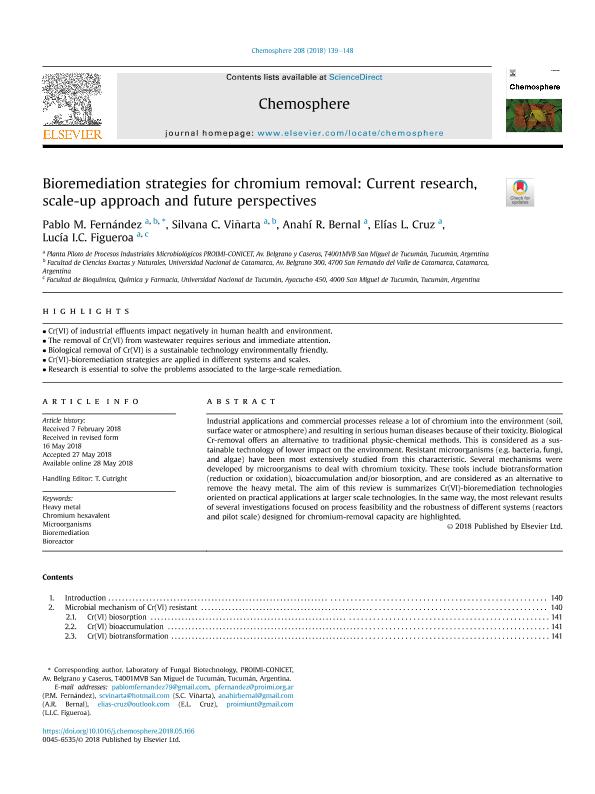Artículo
Bioremediation strategies for chromium removal: Current research, scale-up approach and future perspectives
Fernández, Pablo Marcelo ; Viñarta, Silvana Carolina
; Viñarta, Silvana Carolina ; Bernal, Anahi Romina
; Bernal, Anahi Romina ; Castellanos, Lucia Ines
; Castellanos, Lucia Ines
 ; Viñarta, Silvana Carolina
; Viñarta, Silvana Carolina ; Bernal, Anahi Romina
; Bernal, Anahi Romina ; Castellanos, Lucia Ines
; Castellanos, Lucia Ines
Fecha de publicación:
05/2018
Editorial:
Pergamon-Elsevier Science Ltd
Revista:
Chemosphere
ISSN:
1879-1298
e-ISSN:
0045-6535
Idioma:
Inglés
Tipo de recurso:
Artículo publicado
Clasificación temática:
Resumen
Industrial applications and commercial processes release a lot of chromium into the environment (soil, surface water or atmosphere) and resulting in serious human health diseases because of their toxicity. Biological Cr-removal offers an alternative to traditional physic-chemical methods. This is considered as a sustainable technology of lower impact on the environment. Resistant microorganisms (e.g. bacteria, fungi, and algae) have been most extensively studied from this characteristic. Microorganisms have evolved diverse mechanisms to cope with Cr toxicity. These tools include the metal uptake, which can either occur actively (bioaccumulation) or passively (biosorption), and/or the biotransformation (reduction or oxidation), are considered as an alternative to remove the heavy metal. The aim of this paper is summarizes Cr(VI)-bioremediation technologies oriented on practical applications at larger scale technologies. In the same way, a comparative study of different systems (reactors) and the most relevant results of several investigations focused on the evaluation of the process feasibility and the robustness of the pilot scale system trials in chromium-removal capacity are highlighted.
Palabras clave:
Heavy Metal
,
Chromium Hexavalent
,
Microorganisms
,
Bioremeditaion
Archivos asociados
Licencia
Identificadores
Colecciones
Articulos(PROIMI)
Articulos de PLANTA PILOTO DE PROC.IND.MICROBIOLOGICOS (I)
Articulos de PLANTA PILOTO DE PROC.IND.MICROBIOLOGICOS (I)
Citación
Fernández, Pablo Marcelo; Viñarta, Silvana Carolina; Bernal, Anahi Romina; Castellanos, Lucia Ines; Bioremediation strategies for chromium removal: Current research, scale-up approach and future perspectives; Pergamon-Elsevier Science Ltd; Chemosphere; 208; 10; 5-2018; 139-148
Compartir
Altmétricas



